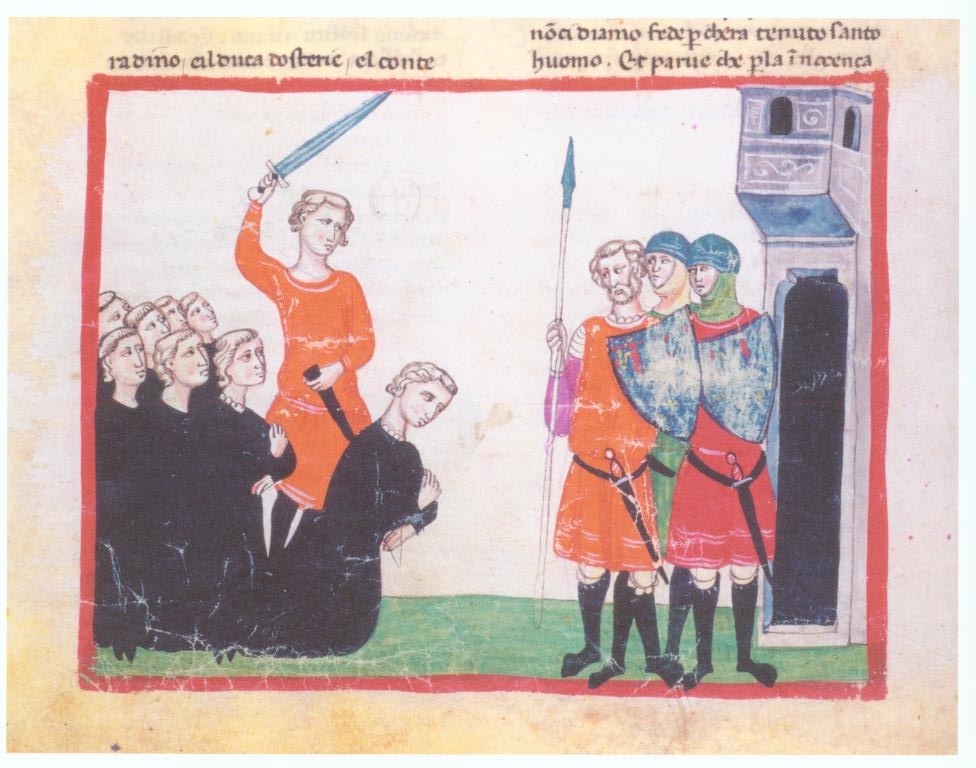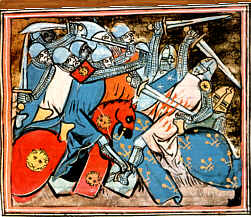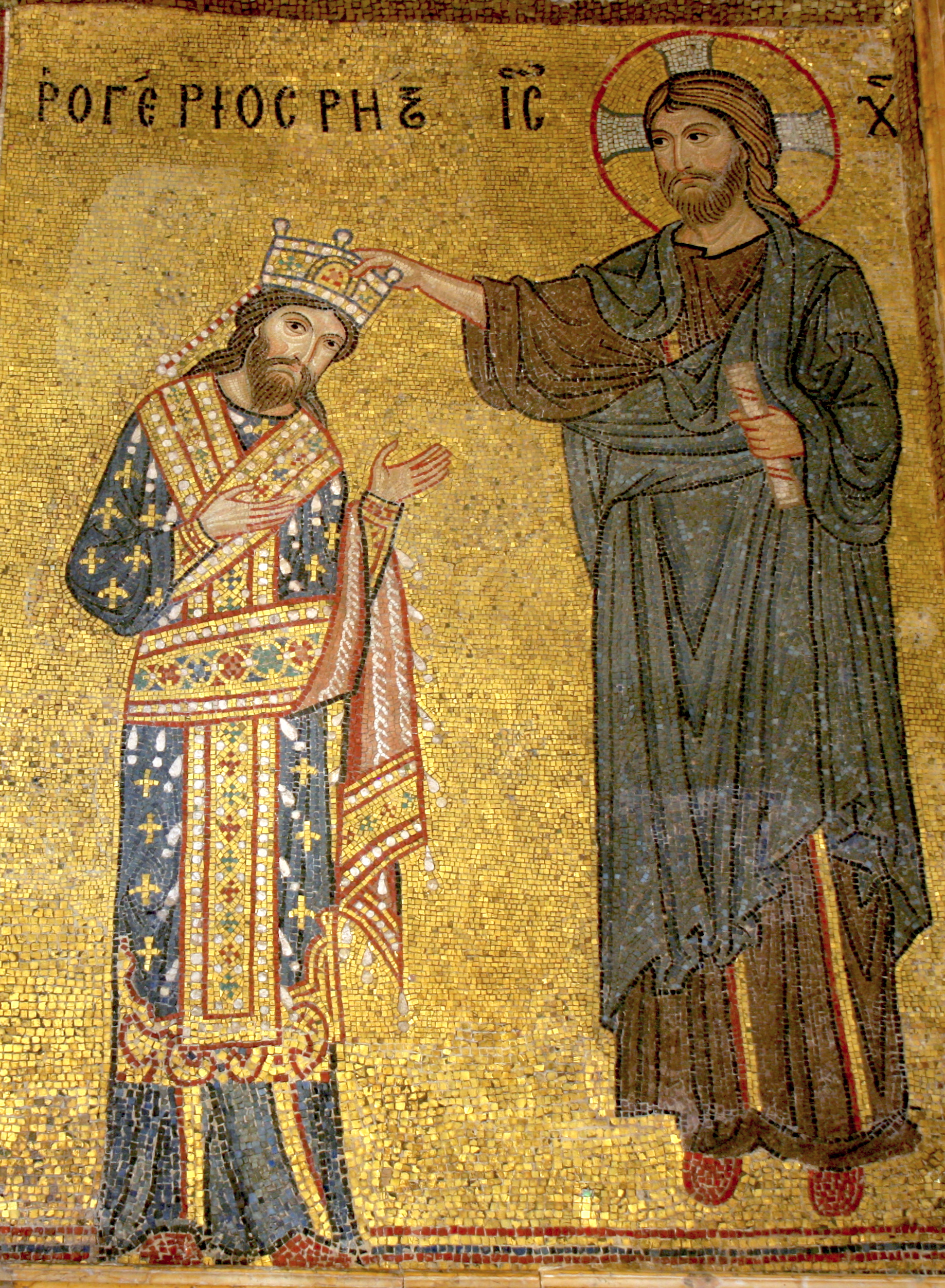|
Conradin
Conrad III (25 March 1252 – 29 October 1268), called ''the Younger'' or ''the Boy'', but usually known by the diminutive Conradin (, ), was the last direct heir of the House of Hohenstaufen. He was Duke of Swabia (1254–1268) and nominal King of Jerusalem (1254–1268) and King of Sicily, Sicily (1254–1258). After Battle of Tagliacozzo, his attempt to reclaim the Kingdom of Sicily for the Hohenstaufen dynasty failed, he was captured and beheaded. Early childhood Conradin was born in Landshut, Wolfstein, Bavaria, to Conrad IV of Germany and Elisabeth of Bavaria, Queen of Germany, Elisabeth of Bavaria. Though he never succeeded his father as King of the Romans, Roman-German king, he was recognized as king of Sicily and Jerusalem by supporters of the Hohenstaufens in 1254. Having lost his father in 1254, he grew up at the court of his uncle and guardian, Louis II, Duke of Bavaria. His guardians were able to hold Swabia for him. Jerusalem was held by a relative from the royal h ... [...More Info...] [...Related Items...] OR: [Wikipedia] [Google] [Baidu] |
Battle Of Tagliacozzo
The Battle of Tagliacozzo was fought on 23 August 1268 between the Ghibelline supporters of Conradin of Hohenstaufen and the Guelph army of Charles of Anjou. The battle represented the last act of Hohenstaufen power in Italy. The capture and execution of Conradin several months after the battle also marked the fall of the family from the Imperial and Sicilian thrones, leading to the new chapter of Angevin domination in Southern Italy. Antecedents The German emperors of the Hohenstaufen line, who had inherited the kingdom of Sicily from its Norman rulers in 1197, had continually attempted to consolidate their more long-standing claims to northern Italy as well—an ambition which was vehemently opposed by many northern Italian states and by the Papacy. The resulting struggle between the Papacy and the Holy Roman Empire split the loyalties of many Italians and led to factionalism, the resulting factions being termed the Guelphs and Ghibellines. The death of the German empe ... [...More Info...] [...Related Items...] OR: [Wikipedia] [Google] [Baidu] |
Manfred Of Sicily
Manfred (; 123226 February 1266) was the last King of Sicily from the Hohenstaufen dynasty, reigning from 1258 until his death. The natural son of the Holy Roman Emperor Frederick II, Manfred became regent over the Kingdom of Sicily on behalf of his nephew Conradin in 1254. As regent he subdued rebellions in the kingdom, until in 1258 he usurped Conradin's rule. After an initial attempt to appease Pope Innocent IV, he took up the ongoing conflict between the Hohenstaufens and the papacy through combat and political alliances. He defeated the papal army at Foggia on 2 December 1254. Excommunicated by three successive popes, Manfred was the target of a Crusade (1255–66) called first by Pope Alexander IV and then by Urban IV. Nothing came of Alexander's call, but Urban enlisted the aid of Charles of Anjou in overthrowing Manfred. Manfred was killed during his defeat by Charles at the Battle of Benevento, and Charles assumed kingship of Sicily. Early life ... [...More Info...] [...Related Items...] OR: [Wikipedia] [Google] [Baidu] |
Hohenstaufen
The Hohenstaufen dynasty (, , ), also known as the Staufer, was a noble family of unclear origin that rose to rule the Duchy of Swabia from 1079, and to royal rule in the Holy Roman Empire during the Middle Ages from 1138 until 1254. The dynasty's most prominent rulers – Frederick I (1155), Henry VI (1191) and Frederick II (1220) – ascended the imperial throne and also reigned over Italy and Burgundy. The non-contemporary name of 'Hohenstaufen' is derived from the family's Hohenstaufen Castle on Hohenstaufen mountain at the northern fringes of the Swabian Jura, near the town of Göppingen. Under Hohenstaufen rule, the Holy Roman Empire reached its greatest territorial extent from 1155 to 1268. Name The name Hohenstaufen was first used in the 14th century to distinguish the 'high' (''hohen'') conical hill named Staufen in the Swabian Jura (in the district of Göppingen) from the village of the same name in the valley below. The new name was applied to the hill c ... [...More Info...] [...Related Items...] OR: [Wikipedia] [Google] [Baidu] |
House Of Hohenstaufen
The Hohenstaufen dynasty (, , ), also known as the Staufer, was a noble family of unclear origin that rose to rule the Duchy of Swabia from 1079, and to royal rule in the Holy Roman Empire during the Middle Ages from 1138 until 1254. The dynasty's most prominent rulers – Frederick I (1155), Henry VI (1191) and Frederick II (1220) – ascended the imperial throne and also reigned over Italy and Burgundy. The non-contemporary name of 'Hohenstaufen' is derived from the family's Hohenstaufen Castle on Hohenstaufen mountain at the northern fringes of the Swabian Jura, near the town of Göppingen. Under Hohenstaufen rule, the Holy Roman Empire reached its greatest territorial extent from 1155 to 1268. Name The name Hohenstaufen was first used in the 14th century to distinguish the 'high' (''hohen'') conical hill named Staufen in the Swabian Jura (in the district of Göppingen) from the village of the same name in the valley below. The new name was applied to the hill castle ... [...More Info...] [...Related Items...] OR: [Wikipedia] [Google] [Baidu] |
Elisabeth Of Bavaria (1227–1273)
Elisabeth of Bavaria ( – 9 October 1273) was Queen of Germany and Jerusalem from 1246 to 1254 by her marriage to King Conrad IV of Germany. Life Elisabeth was born at Trausnitz Castle in Landshut, the eldest daughter of Otto II Wittelsbach and his wife Agnes of the Palatinate, herself a daughter of the Welf count palatine Henry V and Agnes of Hohenstaufen. Otto II succeeded his father Louis I as Bavarian duke and as Count palatine in 1231. In the conflict between the Hohenstaufen emperor Frederick II and the Roman Curia, he initially sided with the pope, but became a supporter of Frederick in 1241. Otto II had initially betrothed Elisabeth to Duke Frederick II of Austria, however, the new political alliance would lead to the marriage of the elder daughter of the Wittelsbach and the elder son of the Hohenstaufen, Conrad IV. The wedding ceremony took place on 1 September 1246, probably at Vohburg in Bavaria, against fierce protests by the papal legate Albert von ... [...More Info...] [...Related Items...] OR: [Wikipedia] [Google] [Baidu] |
Conrad IV Of Germany
Conrad (25 April 1228 – 21 May 1254), a member of the Hohenstaufen dynasty, was the only son of Emperor Frederick II from his second marriage with Queen Isabella II of Jerusalem. He inherited the title of King of Jerusalem (as Conrad II) upon the death of his mother in childbed. Appointed Duke of Swabia in 1235, his father had him elected King of Germany (King of the Romans) and crowned King of Italy (as Conrad IV) in 1237. After the emperor was deposed and died in 1250, he ruled as King of Sicily (Conrad I) until his death. Early years He was the second child, but only surviving son of Emperor Frederick II and Isabella II (Yolanda), the queen regnant of Jerusalem. Born in Andria, in the South Italian Kingdom of Sicily, his mother died shortly after giving birth to him and he succeeded her as monarch of the Crusader state of Jerusalem. By his father, Conrad was the grandson of the Hohenstaufen emperor Henry VI and great-grandson of Emperor Frederick Barbarossa. He live ... [...More Info...] [...Related Items...] OR: [Wikipedia] [Google] [Baidu] |
Kingdom Of Sicily
The Kingdom of Sicily (; ; ) was a state that existed in Sicily and the southern Italian peninsula, Italian Peninsula as well as, for a time, in Kingdom of Africa, Northern Africa, from its founding by Roger II of Sicily in 1130 until 1816. It was a successor state of the County of Sicily, which had been founded in 1071 during the Norman conquest of southern Italy, Norman conquest of the southern peninsula. The island was divided into Three valli of Sicily, three regions: Val di Mazara, Val Demone and Val di Noto. After a brief rule by Charles of Anjou, a revolt in 1282 known as the Sicilian Vespers threw off Capetian House of Anjou, Angevin rule in the island of Sicily. The Angevins managed to maintain control in the mainland part of the kingdom, which became a separate entity also styled ''Kingdom of Sicily'', although it is retroactively referred to as the Kingdom of Naples. Sicily (officially known as the Kingdom of Trinacria between 1282 and 1442) at the other hand, remained a ... [...More Info...] [...Related Items...] OR: [Wikipedia] [Google] [Baidu] |
King Of Sicily
The monarchs of Sicily ruled from the establishment of the Kingdom of Sicily in 1130 until the "perfect fusion" in the Kingdom of the Two Sicilies in 1816. The origins of the Sicilian monarchy lie in the Norman conquest of southern Italy which occurred between the 11th and 12th century. Sicily, which was ruled as an Islamic Emirate of Sicily, emirate for at least two centuries, was invaded in 1071 by Normans, Norman House of Hauteville, who conquered Palermo and established a feudal county named the County of Sicily. The House of Hauteville completed their conquest of Sicily in 1091. In 1130, the County of Sicily and the County of Apulia, ruled by different branches of the House of Hauteville, merged as the Kingdom of Sicily, and Count Roger II of Sicily, Roger II was crowned king by Antipope Anacletus II. In 1282, after the Sicilian Vespers, the kingdom split into separate states: the properly named "Ultra Sicily" (''Siciliae ultra Pharum'', Latin for "Sicily over the Strait of M ... [...More Info...] [...Related Items...] OR: [Wikipedia] [Google] [Baidu] |
Duke Of Swabia
The Dukes of Swabia were the rulers of the Duchy of Swabia during the Middle Ages. Swabia was one of the five stem duchy, stem duchies of the medieval German kingdom, and its dukes were thus among the most powerful magnates of Germany. The most notable family to rule Swabia was the Hohenstaufen family, who held it, with a brief interruption, from 1079 until 1268. For much of that period, the Hohenstaufen were also Holy Roman Emperors. With the death of Conradin, the last Duke of Hohenstaufen, the duchy itself disintegrated although King Rudolph I of Germany, Rudolf I attempted to revive it for his Habsburg family in the late 13th century. Dukes of Swabia (909–1268) Early dukes * Burchard I Hunfriding (d. 911), mentioned as ''marchio'' (margrave) in 903 and ''dux'' (duke) in 909 * Erchanger, Duke of Swabia, Erchanger Ahalolfing, dominant count in Alemannia after the execution of Burchard I, declared duke in 915, exiled September 916, executed January 917. * Burchard II, Duke of ... [...More Info...] [...Related Items...] OR: [Wikipedia] [Google] [Baidu] |
Louis II, Duke Of Bavaria
Louis the Strict () (13 April 1229 – 2 February 1294) was Duke of Upper Bavaria and Count Palatine of the Rhine from 1253. He is known as Louis II or Louis VI following an alternative numbering. Born in Heidelberg, he was a son of Otto II Wittelsbach, Duke of Bavaria and Agnes of the Palatinate. Biography In 1246, the young Louis supported his brother-in-law King Conrad IV of Germany against the usurpation of Heinrich Raspe. In 1251, Louis was at war again against the bishop of Regensburg. Louis succeeded his father Otto as Duke of Bavaria in 1253. When the Wittelsbach country was divided in 1255 among Otto's sons, Louis received the Palatinate and Upper Bavaria, while his brother duke Henry XIII of Bavaria received Lower Bavaria. This partition was against the law and therefore caused the anger of the bishops in Bavaria who later allied themselves with king Ottokar II of Bohemia in 1257. During the German interregnum, after King William's death in 1256, Louis ... [...More Info...] [...Related Items...] OR: [Wikipedia] [Google] [Baidu] |
King Of Jerusalem
The king or queen of Jerusalem was the supreme ruler of the Kingdom of Jerusalem, a Crusader state founded in Jerusalem by the Latin Church, Latin Catholic leaders of the First Crusade, when the city was Siege of Jerusalem (1099), conquered in 1099. Most of them were men, but there were also List of queens of Jerusalem#Queens regnant of Jerusalem, five queens regnant of Jerusalem, either reigning alone ''suo jure'' ("in her own right"), or as coregency, co-rulers of husbands who reigned as kings of Jerusalem ''jure uxoris'' ("by right of his wife"). Godfrey of Bouillon, the first ruler of the Kingdom of Jerusalem, refused the title of king choosing instead the title , that is Advocate or Defender of the Church of the Holy Sepulchre. In 1100 Baldwin I of Jerusalem, Baldwin I, Godfrey's successor, was the first ruler crowned as king. The crusaders in Jerusalem were Siege of Jerusalem (1187), conquered in 1187, but their Kingdom of Jerusalem survived, moving the capital to Acre, Is ... [...More Info...] [...Related Items...] OR: [Wikipedia] [Google] [Baidu] |








